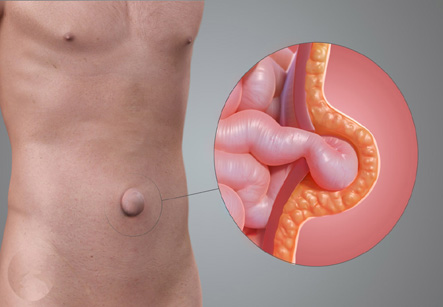Umbilical Hernia
Introduction
An umbilical hernia occurs when abdominal contents such as intestine, fat, or fluid push through a weak spot in the belly. This causes a bulge near the belly button, or navel.
• In children
Umbilical hernias often occur in infants. Mostly, they close on their own by the time a baby is 1 year old. But sometimes surgical treatment is needed.
• In adults
Umbilical hernias can also occur in adults. They usually occur in people who have health problems which create pressure in the belly. They include being overweight, being pregnant, or having too much fluid in the belly (ascites). Other health problems can also lead to umbilical hernia. These include a chronic cough or constipation, and problems in urinating due to an enlarged prostate gland. Most of the time, a doctor can diagnose an umbilical hernia during a physical exam.
An umbilical hernia operation usually takes about 20 or 30 minutes to complete.

Signs and symptoms of an umbilical hernia:
A symptom is something the patient experiences and describes, while a sign is something other people, such as the doctor notice.
There may be a soft bulge or swelling near the umbilicus, ranging from about 1 to 5 cms in diameter (0.5 to 2 inches). The bulge becomes more noticeable if the baby cries, laughs, coughs or strains.
Pain –the umbilical hernia in children and infants is not usually painful. Adults may feel some pain or discomfort.
Causes of an umbilical hernia:
Babies – as the fetus develops inside the mother’s uterus (womb), there is a natural small opening in the abdominal muscles allowing the umbilical cord to pass through. This opening connects the mother to the baby.
Around the time of birth, or shortly afterwards, this opening in the abdominal muscles closes on its own. However, if the opening does not close completely, fatty tissue or part of the bowel can protrude, causing an umbilical hernia.
Adults – if there is excessive pressure on the abdominal wall, fatty tissue or a part of the bowel can poke through a weak part of the abdominal muscles. Individuals at high risk for hernia are more likely to have higher pressure in some areas where fatty tissue or parts of the gut can protrude.
Diagnosis:
A doctor is usually able to diagnose an umbilical hernia during a physical examination. Doctor can also determine what is protruding or what is caught in the hernia sac. This is called content of the hernia.
If the doctor wants to screen for complications, an abdominal ultrasound, X-ray or blood tests may be ordered.
Treatment:
In babies and children, in the majority of cases, the hernia usually closes on its own by the age of 12 months. Sometimes the doctor may be able to push the lump back into the abdomen. However, it is important that only the doctor do this maneuver.
Surgery may be required if:
• The hernia still grows even after the child is one or two years old
• The bulge is still present by the age of four years
• If the hernia blocks the intestines
• If there is trapping or strangulation of hernia
Adults –in case of adults, surgery is usually recommended to prevent potential complications, especially if the hernia grows or starts to cause severe symptoms.
Surgery – this is a small, quick operation to push the bulge back into its place and to make the abdominal wall stronger. In most cases the child may be able to go home on the same day as the surgery.
The surgeon makes an incision at the base of the umbilicus and carefully pushes either the fatty lump or bowel back into the abdomen. Muscle layers are stitched and reinforced over the weak area in the abdomen wall. Dissolvable stitches or special glue are used to close the wound. Sometimes the surgeon places a pressure dressing, which remains there for four to five days.
Possible complications of an umbilical hernia:
Complications of umbilical hernia are very rare in children. If the protrusion becomes strangulated (trapped) and cannot be pushed back into the abdominal cavity, it may lose some of its blood supply and become damaged. If the blood supply becomes completely cut off, there is a risk of gangrene or life-threatening infection.
Incarceration or strangulation is also rare in adults, but more common than in children.